звоните: +7 495 204-207-8
e-mail: art@quartagallery.ru
Recent posts
- Необычная судьба тверской художницы Наталии Пономаревой
- Жемчужина деревянной архитектуры русского севера
- Первая народная галерея в Льялово
- Online auction - a practical instruction. How to take part?
- История русской анимации и коллекционирование «истории» мультипликационных фильмов
- История в гравюрах и литографиях уникального печатного издания «Революционная Москва: Третьему конгрессу Коммунистического Интернационала». 1921
- Painting as a Gift
- What happened to frescoes of Kievskaya Metro Station?
Interior within Interior. Exhibition of Russian artists 1930-2015
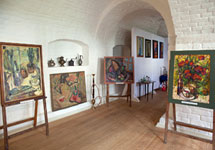
On October 8th this year at the recently renovated House&Museum Mouravieff-Apostol (23/9 Staraya Basmannaya street) there opened a chamber exhibition of the QUARTA Gallery called “Interior within Interior”.
The idea that the canvases presented at the exhibition should somehow be intertwined with the miraculous antique interior of the manor came up spontaneously, affected by the spirit of the place itself. And here they were coming alive, the dreams and visions of the various artists who had worked during the 30s of the previous century alongside those creating their artworks today, placed along the whitewashed walls, under the arched vaults of the manor.
First the viewer dives into an enormous window of the workshop belonging to the famed artist Evgeny Rastorguev in order to have a closer look at Frunzenskaya quay of the middle of the twentieth century , flooded with gauzy lavender light, so unexpectedly real and, at the same time, so irresponsibly surrealistic and daring in the context of the epoch. The ethereal work of the same author “On the Balcony” will touch the viewer lightly with its wind filled with solar energy before taking him further to the stand dedicated to Evsey Reshin and covered all over with the miniatures of the 30s of the 20 th century intricately executed by the masterly hand. Each artwork is a fragment of non-existing reality, texturized, detailed and painted with utmost authenticity. The same detailed character, though obviously of a more romantic nature, shows through the interiors created by the similarly skillful woman’s hand belonging to Nadezhda Vorobieva. Her interiors remind some mysterious creatures deeply asleep and occasionally awakened by the unsteady light.
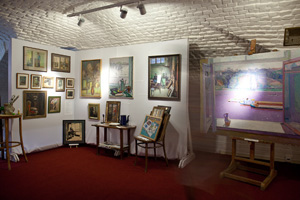
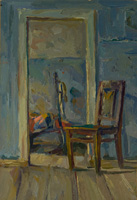
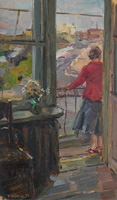
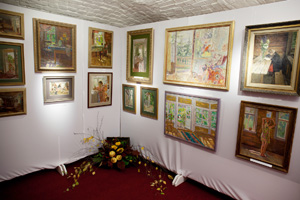
When finally the viewer looks up from the artist’s table where there lay cozily so many peculiar items, including the green wineglass literally stolen from Pyotr Konchalovsky’s canvas, he stands there wondering. The next stand presents two authors whose works look clearly ahead of their time. The avant-garde interiors created by the well-known Russian architect Vassily Minyaev strike you with their daring character and freshness. While the transparent artworks by Natalia Orlova, the artist discovered by the QUARTA Gallery, who passed away rather early, teeter on the brink and unambiguously emit the odor of the 60s, disinhibition and carelessness of the genuinely gifted artist. Nevertheless, the next mini-hall will immerse the viewer into the comfortable atmosphere of the dacha season. From different corners of the hall joyful exclamations can be heard commenting on the habitual interior of suburban Moscow dachas with their familiar sagging doors, cupboards, chairs and bedside tables… Despite the time gap between the viewer and the dacha interiors depicted by Inna Mednikova, Nadezhda Vorobieva and Evgeny Rastorguev, they invariably produce the déjà vu effect and seem to wrap the viewer with their warmth, rocking him to sleep and making him feel the everlasting continuity.
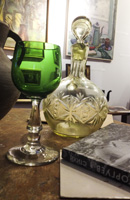
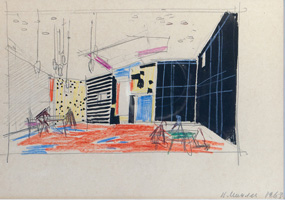
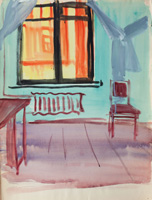
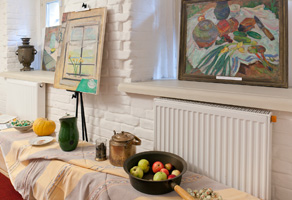
Having escaped from the gentle arms of dachas the viewer finds himself in the world of theatrical phantasmagoria, where decorativeness and conventionality are of specific value. Vibrant artworks by the prominent theatre artist Tamara Guseva co-exist with exquisite miniatures showing the stairs of Odessa theater or colossal columns of Ostankino estate yielding the unmistakable scent of theatrical backstage, heavy velvet curtains and scratchy red carpets. Nearby, though somewhat apart, not yet a theater but already non-reality, stands the artwork by contemporary painter Andrey Kofman called “Interior”: powerful fantastic canvas inhabited by winged creatures submerged into their chaotically focused world, which has already been bravely named “new Bosch” by some of the viewers.
In a small hall, near an enormous mirror there are two paintings created almost at the same time but standing so obviously far apart in terms of perception, at least an epoch away. Tamara Guseva’s “Table of the Poet” is full of subdued tones as if the author just touches upon the mystery of the word, while the sketch to а Shakespeare comedy created by Natalia Kagramanova deafens the viewer with the rave of color and the might of its texture.
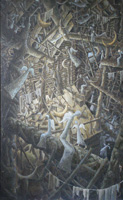
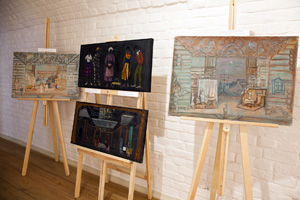
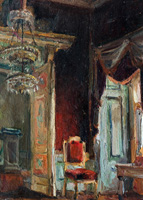
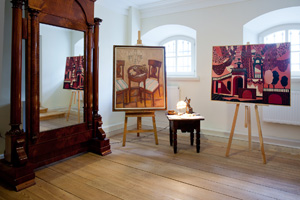
The contemporary hall is presented by various artists and arouses exceptional interest in the viewers moving endlessly past the Oriental corner furnished with, for example, the delicious still life by Nina Gabrielyan whose enigmatic technique evokes lots of questions. «Looks like pointillism…», - a puzzled comment comes from a tall lady in a black dress. Beside it stands a still life by Lev Rapoport, more reserved in colors but reminding a holographic print of reality, and between them there is a tender pink canvas by Ekaterina Tikhonova looking like half a painting half an installation.
Stumbling over a shabby table belonging to the times of “communalka” with Guillaume Apollinaire’s poems and a paraffin lamp on it, the viewer finds himself in the 70s though reinvented by the modern artist Oleg Ivanov and seen as either a message from the future or as the “absolute peace of things and optical vision” of David Shterenberg.
Once again the link of times leads the viewer in circles. One of the late works by Nadezhda Vorobieva “Interior with a little dog” with a cozy but lonely-looking sewing machine in the center is clearly connected with her daughter Ekaterina Tikhonova’s painting, performed in a totally different manner, with vibrant colors, where, nevertheless, the table from the same sewing machine can be spotted under the vase with flowers. And in the middle there is a window again. A girl and a dog swimming in the ghostly light of the afternoon sun; the daydreaming painting evoking ideas of warm Venetian pavements where myth and reality walk side by side.
And finally the viewer faces the last wall which should supposedly be inhabited by everyday life, characteristic of modern photography. However, the works by Dmitry Kalyazensky are incredibly far from reality and strive to reveal its esoteric insides, to touch the mystery of the genesis, to bore into it with its cold optic gaze. Printed with the use of the old-fashioned technology the black-and-white photos of the “Ъ” (Yat) series are pictures – hallucinations coming out of the translucent mist and disappearing into it again right before the eyes of the astonished viewer, subtly conveying the feeling of elusive time.
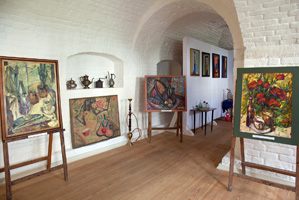
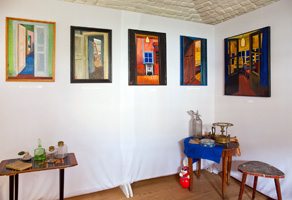
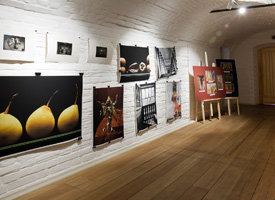
The exhibition will last till October 18th
